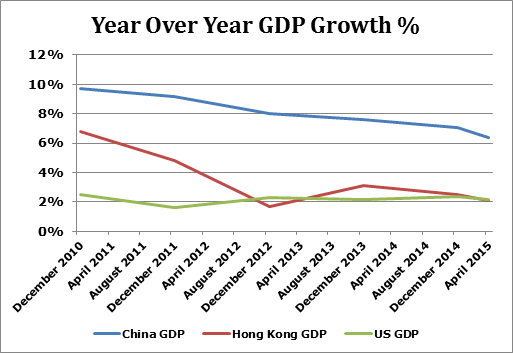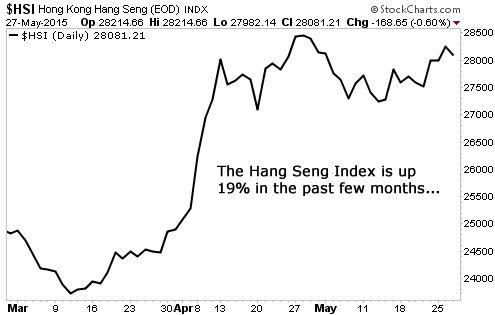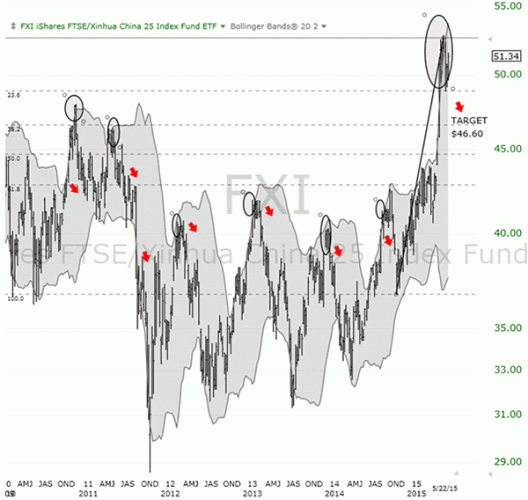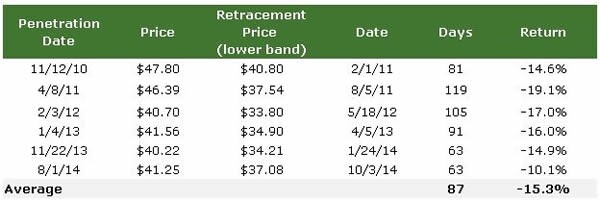Warning: Sell This Now

“Sell in May and go away” is one of those trite pieces of investment advice that traders would be wise to not follow blindly. This year, the Dow and S&P 500 finished up 1% in May, and the Nasdaq rose nearly 3%.
That being said, I did warn my Profit Amplifier readers of one thing they definitely should sell in May. It wasn’t a stock, but a country that is struggling to sustain economic growth — and I saw a chance to make big profits.
Weak Economic Foundation Makes This Market Susceptible
GDP growth in China and Hong Kong has been steadily declining since December 2011. Hong Kong’s growth dropped from 8% in the first quarter of 2012 to 2.1% in the first quarter of 2015.
As a quick note, the city of Hong Kong is part of the country of China, reverting to Chinese rule from British rule in 1997. Hong Kong and China’s legal and governmental relationship is complex but they are economically intertwined, with Hong Kong and Shanghai being the financial hubs of the country.
The chart below shows the trajectories of year-over-year GDP growth for China, Hong Kong and the United States going back to 2010, as these countries were emerging from the Great Recession. You can see that Hong Kong saw the steepest drop, while China has experienced a slow burn despite dramatic government efforts. Many analysts expect growth to continue to slow.

Even if growth stabilizes, the reality is that China’s economic growth doesn’t necessarily translate into strong earnings growth for the companies in the Hang Seng. In fact, this index only returned 14.8% annually (CAGR) from March 2009 until now. For comparison, U.S. GDP was growing at less than half the rate of Hong Kong, yet the S&P 500 gained 21.3% annually (CAGR) from its recession low.
Yet despite the weakening economy, the Hong Kong-based Hang Seng Index jumped 19% in just a few months’ time. Even more disturbing, the rally occurred as annual earnings estimates for companies in the index were falling, sending P/E multiples through the roof.The Chinese government is doing everything it can to keep its currency cheap so exports can continue to thrive. The People’s Republic of China cut rates three times in the past six months, with more cuts likely on the way. Many economists see this as a desperate act that foretells a weak economic future for the nation.

The Hang Seng performed relatively poorly under stronger growth conditions, and I expect it to move much lower now that its economic foundation is crumbling. But I saw an opportunity to profit even if the index only moved back down toward the highs preceding the big run-up in early March.
Finally, there was one more layer to my trade thesis that made the bearish case all the more compelling.
One of my favorite indicators was pointing to lower prices in the iShares China Large-Cap (NYSE: FXI), an ETF that tracks the largest Chinese companies trading on the Hang Seng.
Bollinger Bands are essentially lines that surround a security’s price to help determine when it’s overbought or oversold. If the price pierces the upper Bollinger Band, it’s likely overbought, and I’d look to short. If it breaks through the lower band, it’s likely oversold, and I’d look to buy.
On FXI’s chart, you can see it violated the upper band in a major way.

When this happened before, shares quickly reversed course, making these penetrations predictable and successful short signals.

What made the recent penetration special was that FXI’s advance during the week of April 10 was the largest one-week move since a sell-off that occurred in August 2011, which coincidentally came just after a Bollinger Band sell signal.
I set a downside price target of $ 46.60, based on a 38.2% Fibonacci retracement level of the recent run-up, which was about 10% below where the stock was trading at the time. Looking at the past six occurrences over a four-and-a-half-year period, this target move was on the conservative side, increasing our probability of success.
Since FXI violated the upper band in both the daily and weekly chart, I noted that this indicted the sell-off might be larger in scope, but could take a bit longer to shake out.
So, on May 27, I recommended Profit Amplifier readers buy FXI put options with a $ 56 strike price that expired in November in anticipation of this decline, thinking we might stay in the trade for the duration of the summer. The options closed around $ 7.20, and I set a target of $ 9.80 for them, which would have generated a 36% profit in just few months if my thesis played out.
Well, the sell-off got under way even more quickly than I anticipated. The next day, FXI gapped down nearly 4% on the open. This also meant the price of the put option shot up, and it went right through my buy under price and hasn’t looked back since. It has already gained almost 20% on a 5% drop in FXI. And for all the reasons mentioned above, I doubt the selling is over yet.
That is the nature of options. They are volatile and fast-paced securities, but they are also the fastest way to make huge gains in the market on comparatively modest moves in stocks. Plus, they require a much smaller investment than buying or shorting a stock.
Since I launched Profit Amplifier in late February, I’ve used options to turn an 11% move in Keurig Green Mountain (NASDAQ: GMCR) into a 34% return in 56 days, a 13% move in Yelp (NYSE: YELP) into a 40% gain in 29 days, and an 11% move in Valero Energy (NYSE: VLO) into a 91% profit in 15 days.
With options, no matter whether the overall market is headed up or down, there’s always another opportunity — if you know where to look.
If you’re interested in getting my next trade or learning more about how I go about selecting winning options, check out this short presentation.


